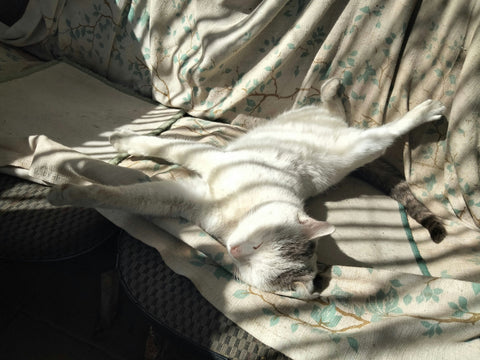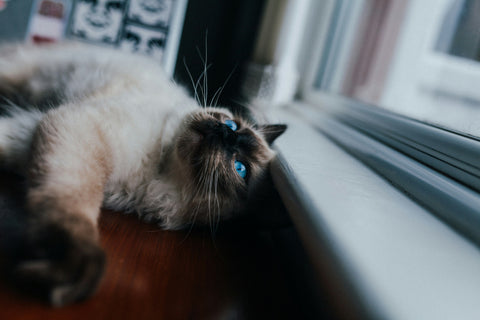The Science of Purring: How Cats Show Affection and Why It’s Good for You
For centuries, cats have been adored for their mysterious and independent nature, but one behaviour stands out the most—purring. The soothing sound of a cat’s purr has long been associated with comfort and happiness, both for the cat and its owners. But have you ever wondered why do cats purr? Is it a sign of love, or does it serve a deeper biological function?
Why Do Cats Purr?
Purring is one of the most distinctive sounds a cat makes, but it’s not just a simple purr. Unlike meowing, which is often used for communication, purring serves multiple purposes. Scientists have discovered several key reasons as to why cats purr:
1. To Show Affection and Bonding
Cats often purr when they are feeling content, safe, and happy. When your cat curls up in your lap and starts purring, it’s a big sign of trust and relaxation. This behaviour is especially common in kittens, who purr while nursing to communicate with their mother and strengthen their bond. Adult cats keep this behaviour with their human caregivers, essentially treating them as a trusted source of comfort and security.
2. As a Self-Soothing Mechanism
Purring isn’t just for expressing happiness—it also serves as a way for cats to calm themselves. Studies have shown that cats purr when they are in pain, scared, or even near to death. This suggests that purring acts as a self-soothing mechanism, similar to how humans might hum or breathe deeply when trying to relax.
3. For Healing and Pain Relief
One of the most fascinating discoveries about purring is its potential healing power. The frequency of a cat’s purr typically ranges from 25 to 150 Hertz (Hz), which falls within a range known to promote healing in bones, muscles, and tissues. Research suggests that the vibrations produced by purring may help reduce pain, heal injuries faster, and even improve bone density in cats.
4. To Communicate Needs
Some cats use a specific type of purr, known as the "solicitation purr", to get attention from their owners. This purr has a higher frequency embedded within it—similar to the sound of a human baby’s cry—which triggers a caregiver’s instinct to respond. If your cat purrs insistently while staring at you, they may be asking for food, playtime, or affection.
5. To Help Other Animals and Humans Relax
Cats are known to purr not only for themselves but also to comfort others. If you’ve ever noticed your cat purring while lying next to another pet or even a sick or sad human, it’s possible they are trying to provide comfort. This empathetic behaviour makes cats special companions with an innate ability to sense emotions.
How Purring Benefits Humans
It’s not just cats who benefit from purring—humans also experience positive effects from the soothing vibrations. Here are some of the scientifically backed benefits:
1. Stress Reduction and Anxiety Relief
The rhythmic sound of a cat’s purr has a calming effect on humans. Studies have shown that being around a purring cat can lower your cortisol levels (the stress hormone) and increase the production of serotonin, which helps regulate mood. This is why many people find the presence of a cat incredibly comforting, especially during times of stress or sadness.
2. Lower Blood Pressure and Heart Health Benefits
Owning a cat has been linked to a reduced risk of heart disease. A 10-year study conducted by the University of Minnesota found that cat owners were 40% less likely to suffer from heart attacks compared to non-cat owners. The relaxation induced by a cat’s purr likely plays a role in this cardiovascular benefit.
3. Pain Relief and Faster Healing
Just as cats use purring to help heal themselves, some studies suggest that the same frequencies can promote healing in humans. Exposure to frequencies between 25-150 Hz has been linked to increased bone density and muscle regeneration, which means that a purring cat might actually be helping you recover from injuries or joint pain.
4. Better Sleep and Relaxation
Many cat owners find it easier to fall asleep when their cat is purring nearby. The gentle vibrations and repetitive sound can act like a natural white noise machine, drowning out external distractions and promoting deep sleep.
5. Emotional Connection and Mental Health Support
Having a pet cat has been shown to reduce feelings of loneliness and depression. The act of petting a purring cat releases oxytocin, the “love hormone,” which fosters feelings of bonding and emotional well-being. For individuals struggling with mental health challenges, the companionship of a purring cat can be a powerful source of comfort and stability.
Do All Cats Purr?
While most domestic cats purr, not all felines exhibit this behaviour. Interestingly, large wild cats like lions, tigers, and leopards don’t purr in the same way as house cats. Scientists believe that purring is unique to certain species within the feline family, mainly smaller cats like domestic cats, cheetahs, and bobcats. The reason behind this distinction lies in differences in their vocal cord structures.
Can You Encourage Your Cat to Purr More?
If you love the sound of your cat’s purr, there are a few things you can do to encourage more frequent purring:
-
Provide a safe and comfortable environment where your cat feels secure.
-
Pet and cuddle your cat in areas they enjoy, such as under the chin or behind the ears.
-
Talk to your cat in a soft, soothing voice to reinforce positive interactions.
-
Give treats and playtime to strengthen your bond and keep them happy.
-
Respect their boundaries—forcing a cat to cuddle when they don’t want to can have the opposite effect.
Purring is a powerful tool that cats use for communication, healing, and affection. Whether they’re soothing themselves, bonding with their humans, or even helping us relax, the magic of a cat’s purr goes far beyond simple contentment. Next time your cat curls up beside you and starts to purr, appreciate the incredible benefits of this natural phenomenon—it’s their way of saying, "I love you."



Comments (0)
There are no comments for this article. Be the first one to leave a message!